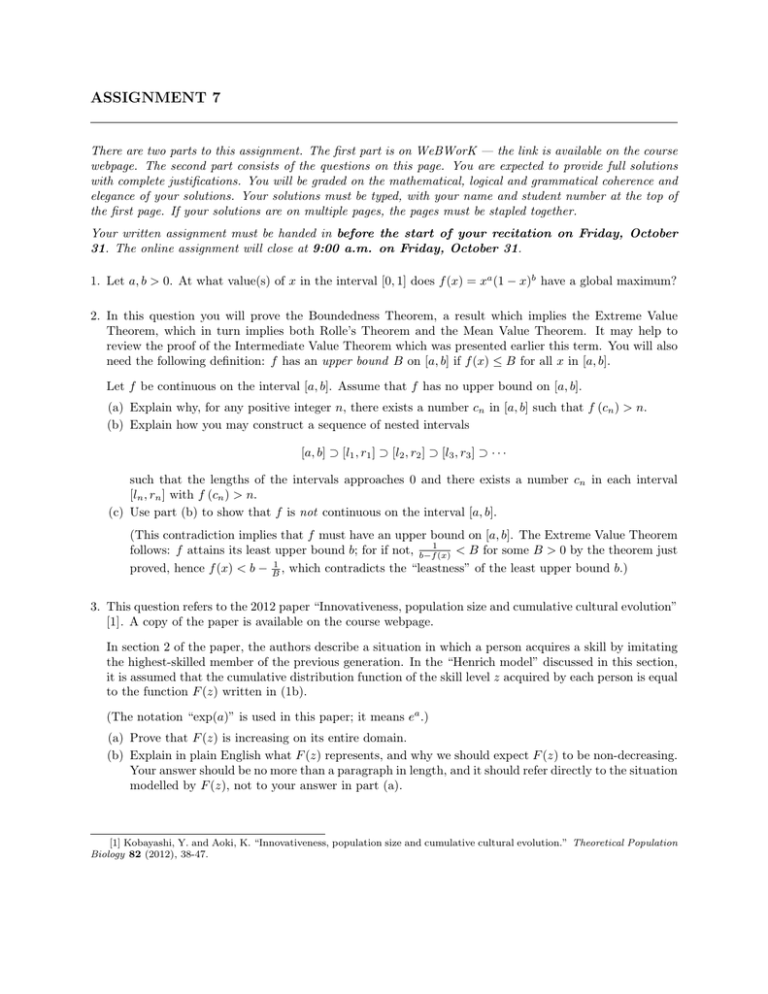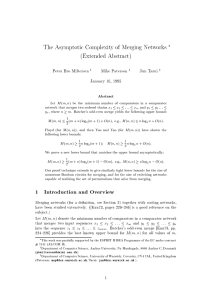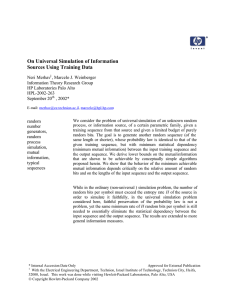ASSIGNMENT 7
advertisement

ASSIGNMENT 7 There are two parts to this assignment. The first part is on WeBWorK — the link is available on the course webpage. The second part consists of the questions on this page. You are expected to provide full solutions with complete justifications. You will be graded on the mathematical, logical and grammatical coherence and elegance of your solutions. Your solutions must be typed, with your name and student number at the top of the first page. If your solutions are on multiple pages, the pages must be stapled together. Your written assignment must be handed in before the start of your recitation on Friday, October 31. The online assignment will close at 9:00 a.m. on Friday, October 31. 1. Let a, b > 0. At what value(s) of x in the interval [0, 1] does f (x) = xa (1 − x)b have a global maximum? 2. In this question you will prove the Boundedness Theorem, a result which implies the Extreme Value Theorem, which in turn implies both Rolle’s Theorem and the Mean Value Theorem. It may help to review the proof of the Intermediate Value Theorem which was presented earlier this term. You will also need the following definition: f has an upper bound B on [a, b] if f (x) ≤ B for all x in [a, b]. Let f be continuous on the interval [a, b]. Assume that f has no upper bound on [a, b]. (a) Explain why, for any positive integer n, there exists a number cn in [a, b] such that f (cn ) > n. (b) Explain how you may construct a sequence of nested intervals [a, b] ⊃ [l1 , r1 ] ⊃ [l2 , r2 ] ⊃ [l3 , r3 ] ⊃ · · · such that the lengths of the intervals approaches 0 and there exists a number cn in each interval [ln , rn ] with f (cn ) > n. (c) Use part (b) to show that f is not continuous on the interval [a, b]. (This contradiction implies that f must have an upper bound on [a, b]. The Extreme Value Theorem follows: f attains its least upper bound b; for if not, b−f1(x) < B for some B > 0 by the theorem just proved, hence f (x) < b − B1 , which contradicts the “leastness” of the least upper bound b.) 3. This question refers to the 2012 paper “Innovativeness, population size and cumulative cultural evolution” [1]. A copy of the paper is available on the course webpage. In section 2 of the paper, the authors describe a situation in which a person acquires a skill by imitating the highest-skilled member of the previous generation. In the “Henrich model” discussed in this section, it is assumed that the cumulative distribution function of the skill level z acquired by each person is equal to the function F (z) written in (1b). (The notation “exp(a)” is used in this paper; it means ea .) (a) Prove that F (z) is increasing on its entire domain. (b) Explain in plain English what F (z) represents, and why we should expect F (z) to be non-decreasing. Your answer should be no more than a paragraph in length, and it should refer directly to the situation modelled by F (z), not to your answer in part (a). [1] Kobayashi, Y. and Aoki, K. “Innovativeness, population size and cumulative cultural evolution.” Theoretical Population Biology 82 (2012), 38-47.








